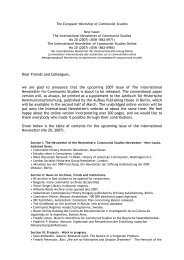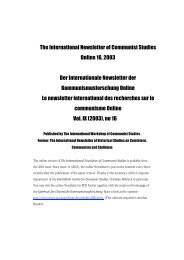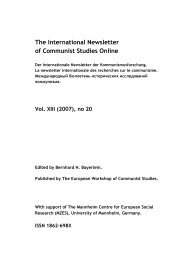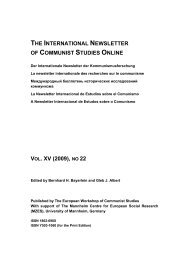VOL. XVI (2010), NO 23 - The International Newsletter of Communist ...
VOL. XVI (2010), NO 23 - The International Newsletter of Communist ...
VOL. XVI (2010), NO 23 - The International Newsletter of Communist ...
Sie wollen auch ein ePaper? Erhöhen Sie die Reichweite Ihrer Titel.
YUMPU macht aus Druck-PDFs automatisch weboptimierte ePaper, die Google liebt.
<strong>The</strong> <strong>International</strong> <strong>Newsletter</strong> <strong>of</strong> <strong>Communist</strong> Studies Online <strong>XVI</strong> (<strong>2010</strong>), no. <strong>23</strong> 86<br />
the world communist movement. Seaman critically described his own place at the congress<br />
as that <strong>of</strong> a “beginner among veterans <strong>of</strong> working-class movement”, 31 but nevertheless he<br />
did not presume to forget neither himself nor the surrounding persons that had taken part in<br />
the foundation <strong>of</strong> three (!) <strong>Communist</strong> Parties in only half a year. It was the record achieved<br />
by Phillips together with his “guru” – Michael Borodin. And the Mexican-American-Spanish<br />
<strong>Communist</strong> was demonstrating his enormous activity in Moscow; he called himself a<br />
delegate <strong>of</strong> the recently formed Cuban <strong>Communist</strong> Section and a delegate <strong>of</strong> the <strong>Communist</strong><br />
Party <strong>of</strong> Spain (which was still in the process <strong>of</strong> creation). However, the leaders <strong>of</strong> the<br />
Comintern stopped all his ambitions and intentions.<br />
Despite the Comintern’s desire to exert its influence over different regions and to widen the<br />
<strong>Communist</strong> ranks, and despite the importance for Moscow to demonstrate an increase in the<br />
number <strong>of</strong> its adherents outside Europe (the “Cuban delegate” would be the second<br />
representative <strong>of</strong> Latin American nations at the congress; the first one was Mexico’s<br />
delegation), on July 17, 1920, the credentials commission decided to restrain Phillips’ ardour<br />
and the issue was delayed until the real credentials would be shown. 32 <strong>The</strong> American-<br />
Mexican <strong>Communist</strong> neophyte was deprived <strong>of</strong> the status <strong>of</strong> a Spanish <strong>Communist</strong> Party’s<br />
delegate. Had Borodin intervened, it would doubtlessly have helped Phillips; however, the<br />
Comintern emissary did not consider the issue important enough while he himself was sent<br />
to another field <strong>of</strong> Comintern work.<br />
A paradoxical situation had formed. Phillips was sent to the Congress by all three <strong>Communist</strong><br />
Parties in whose foundation he had played an active part. However, he had only one <strong>of</strong>ficial<br />
credential issued by the <strong>Communist</strong> Party <strong>of</strong> Spain, but Moscow refused to consider this<br />
document a serious one. <strong>The</strong> Spanish <strong>Communist</strong> Party did not yet exist for Moscow, as the<br />
Comintern was examining its structure and leadership composition and analyzing the<br />
cooperation perspectives.<br />
Finally, the American had to go “back to his roots”, and received the status <strong>of</strong> a Mexican<br />
<strong>Communist</strong> Party representative (Roy’s wife, Evelyn Trent, had subcontracted her<br />
credentials to him). 33 And it was Phillips who had to carry the main responsibility <strong>of</strong><br />
representing the interests <strong>of</strong> the Spanish-speaking countries while his friend and colleague<br />
Manabendra Nath Roy was concentrated in the Asian direction <strong>of</strong> the Comintern’s anticolonialist<br />
strategy. 34 In fact, Phillips appeared to be the only real representative <strong>of</strong> Latin<br />
American communism at the Congress, and he concentrated his efforts in this field <strong>of</strong><br />
revolutionary activity. He presented a draft <strong>of</strong> the Comintern’s tasks in the Western<br />
hemisphere (as seen by him) and concluded that the “overthrow <strong>of</strong> capitalism in America”<br />
31 Shipman, Op. cit., p. 115. <strong>The</strong> Mexican <strong>Communist</strong>s met Lenin during the 2 nd World Congress <strong>of</strong> the Comintern,<br />
or immediately after it. On July 19, 1920, they had a breakfast with Lenin, Zinov’ev, Bucharin, Radek and Gorkii;<br />
after the breakfast the Congress delegates were pictured by a photographer on the steps near the entrance <strong>of</strong> the<br />
Tavricheskii Palace. Later on, in Stalin’s time, the picture was forged and converted into the picture showing Lenin<br />
and Gorkii. <strong>The</strong> <strong>Communist</strong> historiography considered Manuel Díaz Ramírez (the Mexican delegate to the Third<br />
Congress <strong>of</strong> the Comintern) the first Mexican <strong>Communist</strong> to meet Lenin. This error has been even penetrated into<br />
the pages <strong>of</strong> some volumes published by the Institute <strong>of</strong> Marxism and Leninism <strong>of</strong> the CC <strong>of</strong> the CPSU where Jesús<br />
Ramírez’ letter to Lenin was published; however, the commentaries identified Manuel Díaz Ramírez and Jesús<br />
Ramírez as the same person. <strong>The</strong>re is no doubt that Manuel Díaz Ramírez was the first native Mexican who had a<br />
chance to talk with Lenin, but the first Mexican <strong>Communist</strong>s (even not really Mexican by origin) to meet the Soviet<br />
leader were the Hindu Manabendra Nath Roy and the American Phillips (Shipman, Op. cit., pp. 116-119; K. F.<br />
Bogdanova, A. P. Jakushina (eds.): Pis’ma V.I.Leninu iz-za rubezha, Moskva, Mysl’, 1966, p. 146; Leninskii sbornik<br />
XX<strong>XVI</strong>I, Mokvsa, 1970, p. <strong>23</strong>9.<br />
32 Vtoroi kongress Kommunisticheskogo Internatsionala. Iyul’-avgust 1920 g., Moskva, 1934, p. 617; RGASPI,<br />
489/1/27, 1-1ob, 3; RGASPI, 489/1/65, 7ob; RGASPI, 495/1/6, 110.<br />
33 RGASPI, 489/1/27, 1-2; RGASPI, 489/1/30, 90; Vtoroi kongress Kommunisticheskogo Internatsionala.<br />
Stenograficheskii otchet. Petrograd, 1921, p. 354.<br />
34 B.N. Das Gupta: M.N.Roy. Quest for freedom, Calcutta, K. L. Mukhopadhyay, 1970; V.L. Kheifets, L.S. Kheifets:<br />
Psevdonim Borodine. And the real name? La Fayette! // Latinskaia Amerika (1993), 3, pp. 107-115.














